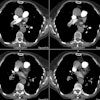Arch Intern Med 2001 Feb 26;161(4):567-71
The impact of the introduction of a rapid D-dimer assay on the diagnostic
evaluation of suspected pulmonary embolism.
Goldstein NM, Kollef MH, Ward S, Gage BF.
BACKGROUND: Rapid D-dimer assays are being used in the diagnostic evaluation of
suspected pulmonary embolism (PE). Although this hypothesis is anticipated to
decrease the use of ventilation-perfusion (VQ) scans and other diagnostic tests
for PE, it has not been tested in a "real-world" environment. SUBJECTS
AND METHODS: A randomized prospective trial was conducted on 470 of the 5390
enrolled patients aged 60 years and older who had previously undergone any
diagnostic tests for PE at an urban teaching hospital. The use of D-dimer as
part of the diagnostic evaluation for PE was promulgated in the 2 randomly
chosen intervention firms. The remaining 2 firms served as controls. MAIN
OUTCOME MEASURES: The number of VQ scans, spiral computed tomographic scans, and
pulmonary angiograms performed. Secondary outcomes included mortality and
thromboembolic or bleeding events during 3 months of follow-up. RESULTS: Of the
470 inpatients who underwent evaluation for PE on a per PE workup basis, fewer
VQ scans were performed in the intervention firms (63.8% vs 81.3%; P<.01).
However, the number of patients evaluated for PE nearly doubled in the
intervention firms (304 vs 166; P<.01), so that more VQ scans were performed
in the intervention than in the control firms (194 vs 135; P<.01).
Ninety-four patients from the control firms and 160 patients from the
intervention firms were diagnosed and treated for venous thromboembolic disease
(P<.01). There were no differences in secondary outcomes during the 3-month
follow-up. CONCLUSIONS: The introduction of a rapid D-dimer assay increased the
number of VQ scans performed because the number of patients screened for PE
increased. A larger number of patients in the intervention firms were diagnosed
as having venous thromboembolic disease (PE and/or deep vein thrombosis). There
were no perceived changes in mortality or venous thromboembolic events during
the 3-month follow-up.







